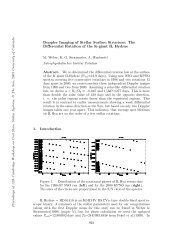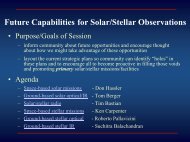Future Instrumentation for Solar and Stellar Research at Radio ...
Future Instrumentation for Solar and Stellar Research at Radio ...
Future Instrumentation for Solar and Stellar Research at Radio ...
You also want an ePaper? Increase the reach of your titles
YUMPU automatically turns print PDFs into web optimized ePapers that Google loves.
Originally conceived as a “red shift machine” oper<strong>at</strong>ing <strong>at</strong> 1.4 GHz<br />
<strong>and</strong> below, the basic idea behind SKA is to push to extremely<br />
high sensitivity. For spectral line work, an increase in b<strong>and</strong>width<br />
is not an option. And receiver technology is now approaching<br />
quantum limits. The solution, there<strong>for</strong>e, is to exploit an<br />
extremely large collecting area: one square kilometer.<br />
To put th<strong>at</strong> in perspective, th<strong>at</strong>’s 100 VLAs!<br />
The community – both n<strong>at</strong>ional <strong>and</strong> intern<strong>at</strong>ional – is behind the<br />
basic concept. But the detailed specific<strong>at</strong>ions <strong>and</strong> how to build it<br />
<strong>at</strong> reasonable cost have not been determined.<br />
Several concepts are being considered. A few are:<br />
Large-N arrays (US)<br />
Large-f-r<strong>at</strong>io mirrors with derigibles (Canada)<br />
Many Arecibos (China)<br />
Adaptive reflectors (NFRA)





